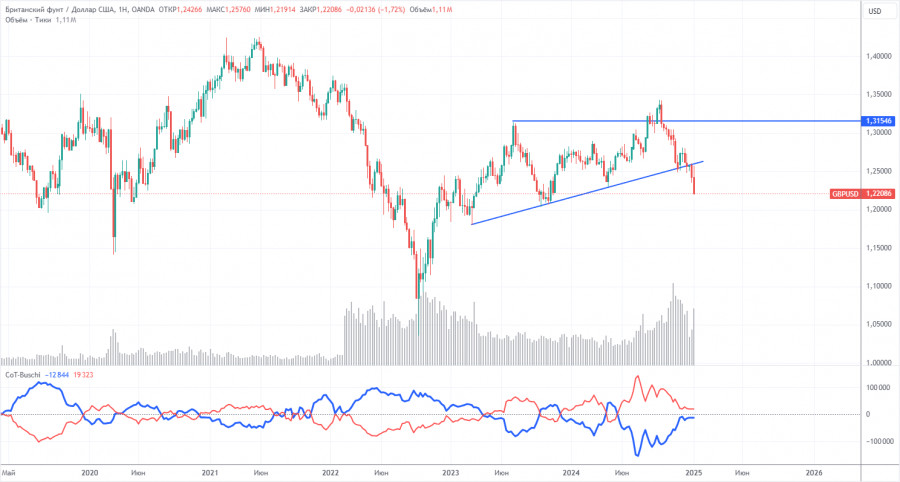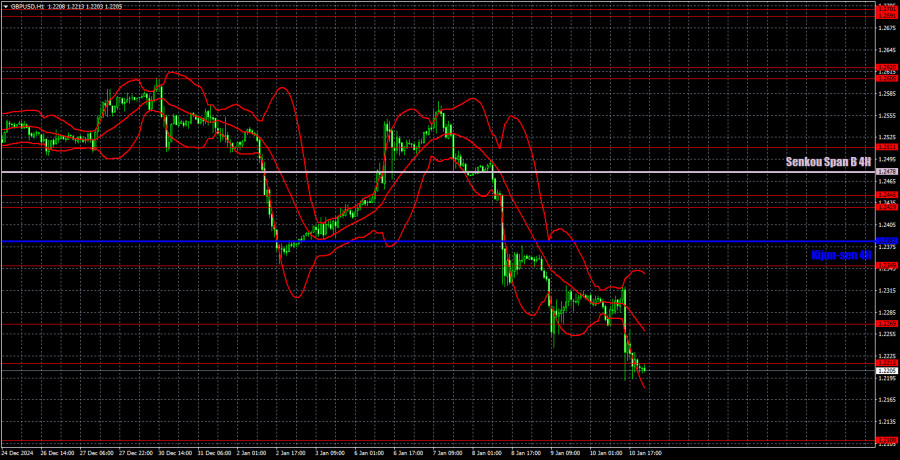

On Friday, the GBP/USD pair continued its downward trend. Essentially, everything discussed in the EUR/USD analysis applies to GBP/USD as well. However, the key difference is that the pound sterling ended the trading week just a few pips above its weekly low, while the euro managed a slight upward rebound. Therefore, we wouldn't be surprised if the pound's decline resumes as early as Monday. Unlike the euro, which may enter a flat phase to avoid further losses, the pound does not appear to have that option. Though we've previously noted the pound's remarkable resilience against the dollar, even this strength has its limits. It now seems that the pound is in free fall.
In addition to the NonFarm Payrolls and unemployment reports, the U.S. also released data on wage growth and consumer sentiment on Friday. However, these reports attracted little attention. Wage growth rose by 0.3%, aligning with forecasts, while the University of Michigan Consumer Sentiment Index was only slightly weaker than expected. Because the deviations from forecasts were minimal or nonexistent, these reports did not have a significant impact on the pair's movements.
At this point, the pound can only hope for a miracle. It is evident across all timeframes that the currency is in nearly freefall, and it remains unclear what might halt this decline. There are only two significant reports this week that have the potential to reverse the trend, even if only temporarily. Additionally, there are no strong support levels below the current price. On the 5-minute timeframe, Friday provided just one trading opportunity—the initial buy signal around the 1.2269 level. However, it would have been prudent to close any positions before the release of the Non-Farm Payrolls and unemployment data.

The latest Commitment of Traders (COT) report for the pound sterling highlights the fluctuating sentiment among commercial traders in recent years. The red and blue lines, representing the net positions of commercial and non-commercial traders, often cross each other and typically hover around the zero mark. Currently, these lines are close together, indicating a roughly equal number of long and short positions.
On the weekly timeframe, the price initially broke below the 1.3154 level and subsequently dropped further, breaching the trendline. This break suggests that the pound's decline is likely to continue in the long term.
According to the latest COT data, the non-commercial group opened 1,600 buy contracts and 100 sell contracts, resulting in a net position increase of 1,500 contracts. However, this does not indicate a positive outlook for the pound.
The fundamental backdrop does not provide any justification for long-term purchases of the pound. Instead, the currency appears to be on the verge of a renewed global downtrend. As a result, the net position may continue to decline, signaling further waning demand for the pound.

On the hourly timeframe, the GBP/USD pair continues to display a downtrend, with the latest correction ending swiftly. Currently, there are no substantial reasons for the pound to increase in value, aside from occasional technical corrections that may be necessary. This trend has been consistent for several weeks, and we expect further declines for the pound in the medium term.
As of January 13, we identify the following key levels: 1.2052, 1.2109, 1.2215, 1.2269, 1.2349, 1.2429-1.2445, 1.2511, 1.2605-1.2620, 1.2691-1.2701, 1.2796-1.2816, and 1.2863. The Senkou Span B at 1.2478 and the Kijun-sen at 1.2382 may also provide important signals. It is advisable to set Stop Loss orders to breakeven once the price moves 20 pips in the desired direction to safeguard against potential losses caused by false signals. Keep in mind that Ichimoku lines can fluctuate throughout the day and should be taken into account when determining signals.
While there are no significant events scheduled in the UK or the U.S. for Monday, the pound is in a precarious position, meaning that the decline could resume immediately after the market opens. Typically, some traders aim to secure profits before the weekend; however, this time that did not occur, indicating a notably strong bearish sentiment.

SZYBKIE LINKI